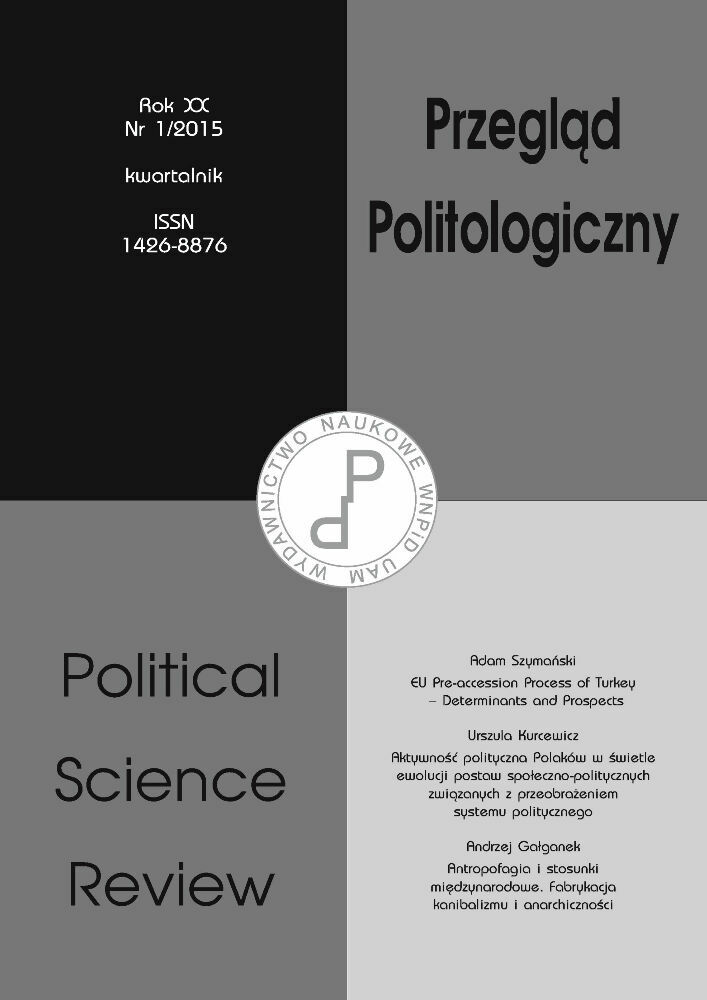Abstract
CasaPound Italia, program and organizational model of which are examined in this article, is one of the most important extreme right-wing socio-political groups currently active in Italy. The aim of the paper is to present the program, organizational structure and principles of operation of CasaPound in terms of the anti-party model formulated by Ryszard Herbut. The theoretical background for the anti-party model’s presentation is a result of a research on the conceptualization of the anti-partisanship’s idea and anti-party attitude (sentiments). Analysis of CasaPound’s campaigns, promoted values, proposed slogans and methods of facing challenges leads to answer to a question of whether it is possible to use the Herbut’s model to describe and systematize the organization’s profile.
References
Bauman Z. (2003), Vita liquida, Laterza, Bari.
Berizzi P., Fascisti del terzo milennio e la Cosa Nera in cerca d’autore, Inchiesta „La Repubblica”, 5.06.2012, http://inchieste.repubblica.it/it/repubblica/rep-it/2012/06/05/news/fas-cisti_e_post-fascisti_del_terzo_millenino-36171750, 10.10.2013.
Betz H.-G. (2003), The Growing Threat of the Radical Right, w: Right-wing Extremism in the Twenty-first Century, red. P. H. Merkl, L. Weinberg, Frank Cass Publishers, London, Portland.
Castells M. (2009), Comunicazione e potere, UBI, Milano.
Daalder H. (1992), A crisis of party? „Scandinavian Political Studies”, vol. 15, nr 4.
Di Nunzio D., Toscano E. (2001), Dentro e fuori CasaPound. Capire il fascismo del terzo milennio, Armando Editore, Roma.
Di Tullio D. (2010), Nessun dolore. Una storia di CasaPound , Rizzoli, Milano.
Herbut R. (2002), Teoria i praktyka funkcjonowania partii politycznych, Wydawnictwo Uniwersytetu Wrocławskiego, Wrocław.
Ignazi P. (1992), The Silent Counter-revolution: Hypotheses on the Emergence of Extreme Right-wing Parties in Europe, „European Journal of Political Research”, nr 22.
Ignazi P. (1996), The intellectual basis of right-wing anti-partysm, „European Journal of Political Research”, nr 2.
Jankiewicz J. (2007), Nowa skrajna prawica w wybranych panstwach Europy Zachodniej. Analiza porównawcza, Wydawnictwo Adam Marszałek, Toruń.
Mudde C. (1996), Paradox of the Anti-party party: Insights from the Extreme Right, „Party Politics”, vol. 2, nr 2.
Mudde C. (2008), The populist radical right: a pathological normalcy, Willy Brandt Series of Working Papers in International Migration and Ethnic Relations, 3.07.2008, Malmo.
Mudu P. (2004), Resisting and Challenging Neoliberalism: The Development of Italian Social Centers, „Antipode”, Editorial Board of Antipode, Oxford. Oficjalny program polityczny CasaPound Italia, http://www.casapounditalia.org.
Poguntke T., Scarrow S. E. (1996), The Politics of Anti-Party Sentiment: Introduction, „European Journal of Political Research”, nr 29.
Ruggiero V. (2000), New social movements and the ‘centri sociali’ in Milan, „The Sociological Review”, vol. 48, nr 2.
Sani G., Segatti P. (2001), Antiparty Politics and the Restructuring of the Italian Party System, w: red. Parties, Politics and Democracy in the New Southern Europe, P. Nikiforos Diamandouros, R. Gunther, Johns Hopkins University Press, Baltimore–London.
Schedler A. (1996), Anti-political-establishment Parties, „Party Politics”, vol. 2, nr 2.
Taggart P. (1994), Riding the Wave: New Populist Parties in Western Europe, Paper presented at the Joint Sessions of the European Consortium for Political Research, Madrid.
Torcal M., Gunther R., Ramon Montero J. (2001),Anti-party sentiments in Southern Europe, Estudio/Working Paper.
Voerman G., Lucardie P. (1992), The Extreme Right in the Netherlands: The Centrists and Their Radical Rivals, „European Journal of Political Research”, nr 22.
